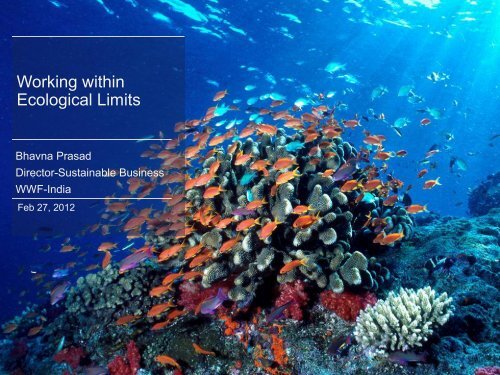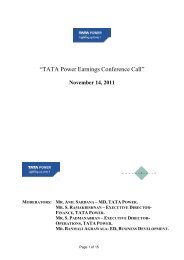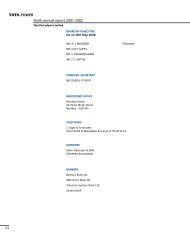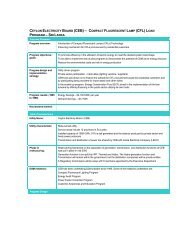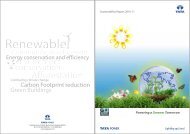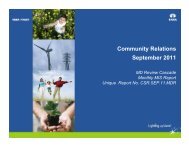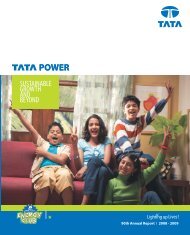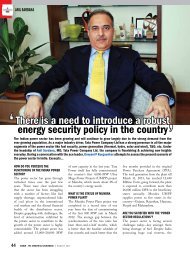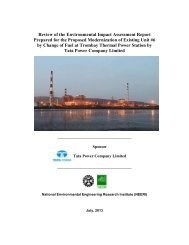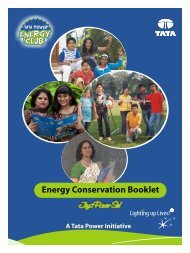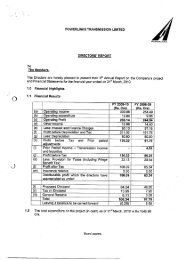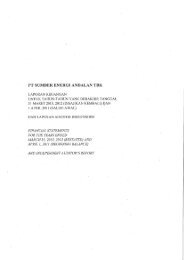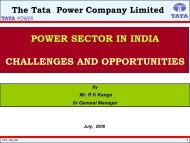WWF India by Ms. Bhavna Prasad - Tata Power
WWF India by Ms. Bhavna Prasad - Tata Power
WWF India by Ms. Bhavna Prasad - Tata Power
You also want an ePaper? Increase the reach of your titles
YUMPU automatically turns print PDFs into web optimized ePapers that Google loves.
Working within<br />
Ecological Limits<br />
<strong>Bhavna</strong> <strong>Prasad</strong><br />
Director-Sustainable Business<br />
<strong>WWF</strong>-<strong>India</strong><br />
Feb 27, 2012
Agenda<br />
<br />
Ecological limits & factors influencing them<br />
<br />
Implications for businesses<br />
<br />
Sustainable development & some solutions<br />
2
Who we are & where we work<br />
<strong>WWF</strong> is one of the largest global<br />
conservation organisations<br />
Presence in over 40 countries with<br />
projects in over 100 countries<br />
HQ - Gland, Switzerland<br />
<strong>WWF</strong>-<strong>India</strong> was registered as an<br />
<strong>India</strong>n NGO in 1969<br />
Deep scientific knowledge of<br />
environmental issues<br />
Wide national presence<br />
<br />
<br />
<br />
14 State Offices<br />
2 Divisional Offices<br />
27 Field Offices
Ecological Limits<br />
We now consume at a rate 50% faster than Earth can sustain<br />
+100% increase since 1966<br />
Source: Global Footprint Network
Greenhouse Gases (GHGs)<br />
Increased greenhouse gas emissions, primarily carbon dioxide from<br />
human sources (burning of fossil fuels and deforestation)<br />
Co2 Emissions <strong>by</strong> Source<br />
Land Use change<br />
18%<br />
Agriculture<br />
13%<br />
Industrial Processes<br />
3%<br />
Waste<br />
3%<br />
Energy<br />
63%
Climate Change Impacts- Agriculture<br />
<strong>India</strong> may lose up to 17% of its farming income from increase in temperature1<br />
Increased frequency of<br />
Heat waves, droughts<br />
10%<br />
5%<br />
0%<br />
Heavy precipitation<br />
Insect and disease<br />
outbreaks<br />
Africa<br />
Latin America Middle East and North africa Asia Developing CountriesWorld Industrial Countries<br />
Change in Output Potential (2080 as % of 2000)<br />
-5%<br />
-10%<br />
-15%<br />
-20%<br />
Severe impacts for<br />
developing countries<br />
Food security,<br />
malnutrition, poverty,<br />
Wheat yields could fall<br />
<strong>by</strong> 5- 10% with every<br />
increase in temp <strong>by</strong><br />
10C (Pachauri, 2008)<br />
Source-Earth Trends 2008<br />
1 (Mendolsohn, Yale University, 2008)
Freshwater Resources<br />
20 % of world’s population lives without adequate water<br />
Globally<br />
1.1 billion people lack<br />
access to adequate<br />
freshwater<br />
About 2.3 billion people<br />
suffer from diseases<br />
linked to dirty water<br />
NASA, 2009<br />
<strong>India</strong><br />
Nearly 80% of urban<br />
waste ends up in rivers<br />
Rapid decline in<br />
groundwater in <strong>India</strong>’s<br />
Food Basket States
State of the World’s Forests<br />
80% of Earth's original forests have been destroyed<br />
Almost 60% of the<br />
remaining forests are<br />
small, disturbed and<br />
unable to sustain<br />
themselves<br />
High rate of<br />
deforestation for<br />
competing economic<br />
priorities<br />
Forest fires, further<br />
aggravated <strong>by</strong> climate<br />
change<br />
Source: World Resources Institute
Biodiversity Loss<br />
Rate of species extinction 1,000 times faster than natural rate (UNEP)<br />
Habitat loss due to:<br />
Deforestation<br />
Resource extraction<br />
Submergence<br />
Forest fires and loss of<br />
productivity of forests<br />
Changes in temperatures<br />
<strong>India</strong> – endangered species<br />
Tiger<br />
<strong>India</strong>n Elephant<br />
Ganges River Dolphin<br />
Nilgiri Tar
CSE (2004)<br />
Industrial water usage to grow in future<br />
Click to edit Master text styles<br />
Second level<br />
Third level<br />
<br />
Fourth level<br />
– Fifth level<br />
Growing<br />
consumption<br />
By 2030, demand<br />
will be 50% more<br />
than supply<br />
Industrial Water Use – Today<br />
Thermal power plants consume<br />
88% of water within industrial<br />
sector
How these trends interact<br />
Water Scarcity Demography Crop Decline Hunger Coastal Risks Recent Conflicts
Union Carbide and BP<br />
Bhopal gas leak,<br />
Union Carbide<br />
Gulf of Mexico,<br />
BP
Increasing Conflicts
Risk to Businesses<br />
Investor and<br />
disclosure<br />
concerns<br />
Market<br />
pressure<br />
Public and<br />
media<br />
scrutiny<br />
Changing<br />
policies<br />
Community<br />
expectations<br />
atrecnu<br />
Climate and<br />
development<br />
change<br />
intervention (“time”)<br />
r“(<br />
yt<br />
ni
Sustainable Development<br />
“Sustainable development is development that meets the needs of the present without<br />
compromising the ability of future generations to meet their own needs.” (Brundtland<br />
Commision 1987)<br />
SOCIAL<br />
Bearable<br />
Equitable<br />
SUSTAINABLE<br />
ENVIRONMENT<br />
Viable<br />
ECONOMIC<br />
At the 2005 World Summit it was noted that this requires the reconciliation of<br />
environmental , social and economic demands - the overlapping "three pillars" of<br />
sustainability
Work With Market Forces<br />
Forestry<br />
Fisheries<br />
Freshwater<br />
Markets<br />
Places<br />
Banking<br />
Policies<br />
Agriculture<br />
Aquaculture<br />
Government<br />
Climate<br />
Change
Carbon: Reducing Emissions<br />
The Challenge<br />
<strong>WWF</strong>’s Response<br />
Climate Change is a key global<br />
threat that <strong>WWF</strong> has identified<br />
as undermining its other<br />
conservation initiatives<br />
Food Production and<br />
Deforestation are major<br />
contributors<br />
Carbon Disclosure Project<br />
Climate Solvers – Innovation<br />
Earth Hour campaign<br />
Climate Policy and Adaptation
18<br />
CDP Top 200 Report - 2011
Freshwater: Promoting Responsible Stewardship<br />
The Challenge<br />
By 2050, 7 of 9 billion people will<br />
live in areas of water scarcity<br />
Almost a billion people already<br />
lack access to safe drinking<br />
water<br />
Half the world’s wetlands have<br />
been destroyed<br />
<strong>WWF</strong>’s Response<br />
Facilitating development of<br />
voluntary water use standards<br />
Water efficiency in supply chain<br />
e.g. cotton, sugar and rice<br />
Partnering with companies to<br />
measure and reduce “water<br />
footprint”
Wood: Promoting Responsible Forestry<br />
The Challenge<br />
<strong>WWF</strong>’s Response<br />
Increased demand for wood<br />
and paper products<br />
Increased illegal timber trade<br />
and unsustainable forest<br />
management<br />
Companies committing to<br />
responsible forest<br />
management and certification<br />
e.g. ITC<br />
FSC – capacity building
Agriculture: Improving Practices Around The World<br />
The Challenge<br />
<strong>WWF</strong>’s Response<br />
33% of Earth’s surface in crops<br />
or grazing; 55% of habitable<br />
area<br />
Half of the topsoil lost globally<br />
Agriculture uses 70% of the<br />
world’s water<br />
Work with multi-stakeholders to<br />
develop and define credible<br />
standards<br />
Test and demonstrate the<br />
commercial benefits of better<br />
management practices
Cotton – Better Management Practices<br />
Click to edit Master text styles<br />
Second level<br />
● Third level<br />
● Fourth level<br />
● Fifth level<br />
Andhra Pradesh<br />
Maharashtra<br />
District Warangal Aurangabad & Jalna<br />
No. of farmers 1,418 (scaling up) 5,550 (scaling up)<br />
Area 4,081 acres 11,400 ha<br />
No. of villages 28 65<br />
Project supporters<br />
2007-08 (IKEA)<br />
2009-11 (Marks & Spencer)<br />
2009 -13 (IKEA)
Finance: Helping The Financial Sector Make Better<br />
Decisions<br />
The Global Challenge<br />
<strong>WWF</strong>’s Response<br />
Developing better risk<br />
management tools, e.g.HSBC<br />
Encouraging stronger<br />
regulations relating to<br />
sustainability<br />
Educating financial institutions<br />
about emerging risks such as<br />
water security<br />
Financial institutions enable<br />
environmentally and socially<br />
damaging activities through their<br />
lending and investing practices
Thank you


